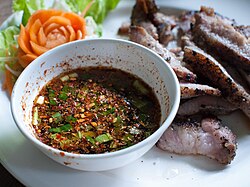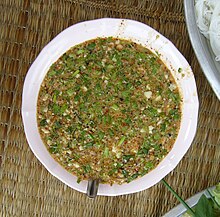Nam chim
 Nam chim chaeo | |
| Type | Dip |
|---|---|
| Place of origin | Thailand |
| Region or state | Southeast Asia |
| Created by | Thai people |

Nam chimornam jim(Thai:น้ำจิ้ม,IPA:[ná(ː)mtɕîm]) isThaifor "dipping sauce".It can refer to a wide variety of dipping sauces inThai cuisine,with many of them a combination of salty, sweet, spicy and sour.[1]
Nam chimtend to be more watery in consistency thannam phrik(Thai chili pastes). AlthoughSriracha sauceis commonly known assot Srirachain Thailand (sotis the Thai pronunciation of the English wordsauce), it is sometimes callednam chim Srirachaornam phrik Sriracha.
A more-or-less generic and basicnam chimis used for grilled or steamed seafood. This sauce contains garlic,fish sauce,sugar,lime juice, andbird's eye chilies.Variations on this basic recipe find their use as a dipping sauce with and as an integral part of many dishes. Many of the ingredients in anam chimare finely chopped or pounded in amortar and pestleor, non-traditionally, ground in ablender.
History[edit]
The history of nam chim can be traced back to theAyutthaya periodof Thailand's history. French diplomatSimon de la Loubère,who visited Siam during the mid-Ayutthaya period, described the use of plain sauces with spices,garlic,chibols,or sweet herbs, as well as a fermented shrimp paste calledkapi,which was commonly used to enhance the flavor of dishes.[2]Many types of nam chim used in different dishes are mentioned in various cookbooks, including "Maekrua Hua Pak" (1908–1909) by Mrs. Plian Passakornwong, and "Nang Suea Kap Khao Son Luklan Kap Pholmai Khong Wang Lae Khanom" (1876-1961) by Mrs. Kleep Mahitorn.[3][4]These early dipping sauces evolved over time, with various regional variations and styles emerging, resulting in countless unique blends of flavors and ingredients found in today's nam chim.
Variants[edit]
Popular dipping sauces in Thailand are:
- Nam chim kai(Thai:น้ำจิ้มไก่),sweet chili sauceis a very common all-round chili dipping sauce with the consistency of a thick syrup. It is mediumspicyand very sweet, normally referred to as "sweet Thai chili sauce" in English. It is often used as a dipping sauce for grilled chicken (kai yang). It can be used as a generic chili sauce for other dishes. It forms the base of a few other types ofnam chim,such asnam chim thot man pla( "dipping sauce for deep-fried fish cakes" ).
- Nam chim chaeo(Thai:น้ำจิ้มแจ่ว), using ground dry-roastedglutinous rice,this sauce is most often eaten withmu yang/mu ping(grilled pork) orkai yang(grilled chicken).[5]
- Nam chim sate(Thai:น้ำจิ้มสะเต๊ะ) is the Thai version ofpeanut sauce;it is eaten with Thaisatay.
- Achat(Thai:อาจาด) is the Thai version of the Malay/Indonesianacartimun(cucumber pickles). The Thai variety consists of fresh chopped cucumber, spring onion and chili, mixed with vinegar. It is usually served withnam chim sateas a dip for satay.
- Nam chim suki(Thai:น้ำจิ้มสุกี้) is eaten with Thaisuki(the Thai version of the Chinesehot pot) andMu kratha.The main ingredients are chili sauce, chili, garlic and sesame seeds.[6]
- Nam chim taochiao(Thai:น้ำจิ้มเต้าเจี้ยว), containingyellow soybean paste(taochiao), is eaten withkhao man kai
- Nam chim thale(Thai:น้ำจิ้มทะเล) — a basic dipping sauce made with garlic, fish sauce, lime juice, sugar and chilis — is usually eaten with grilled or steamed seafood.[7]
- Nam chim thot man(Thai:น้ำจิ้มทอดมัน), served as a dip withthot man pla(fried fish cakes), is similar tonam chim kaibut with chopped cucumber, crushed peanut and coriander (cilantro) leaves. Forthot man kung or pu(fried prawn or crab cakes), however, a very sweet plum sauce is provided.
- Nam chim paesa(Thai:น้ำจิ้มแป๊ะซะ) is served as a sauce for steamed fish wrapped in steamed cabbage leaves.
See also[edit]
- Thai cuisine
- List of Thai ingredients
- List of Thai dishes
- List of condiments
- List of dips
- List of sauces
References[edit]
- ^Bento, Thaifood."Thai Dipping Recipe: Nam Jim Jaew / Nam Chim Chaeo (น้ำจิ้มแจ่ว)".thaifoodbento.
- ^de La Loubère, Simon (1693).A New Historical Relation of the Kingdom of Siam CHAP. IV. Concerning the Table of the Siameses.Translated by A.P.
- ^Plian Passakornwong (1908),ตำราแม่ครัวหัวป่าก์: ตำรากับเข้าของกินอย่างไทยแลเทศ(in Thai)
- ^Kleep Mahitorn (1961),หนังสือกับข้าวสอนลูกหลาน กับ ผลไม้ ของว่าง และขนม / ของ ท่านผู้หญิงกลีบ มหิธร(in Thai)
- ^"How to Make Jaew แจ่ว - Thai Dried Chilli Dipping Sauce - SheSimmers".Retrieved21 September2014.
- ^[1][dead link]
- ^"Clay's Kitchen: Tam Ra Ahan Thai (Thai Recipes) ตำราอาหารไทย".Retrieved21 September2014.

